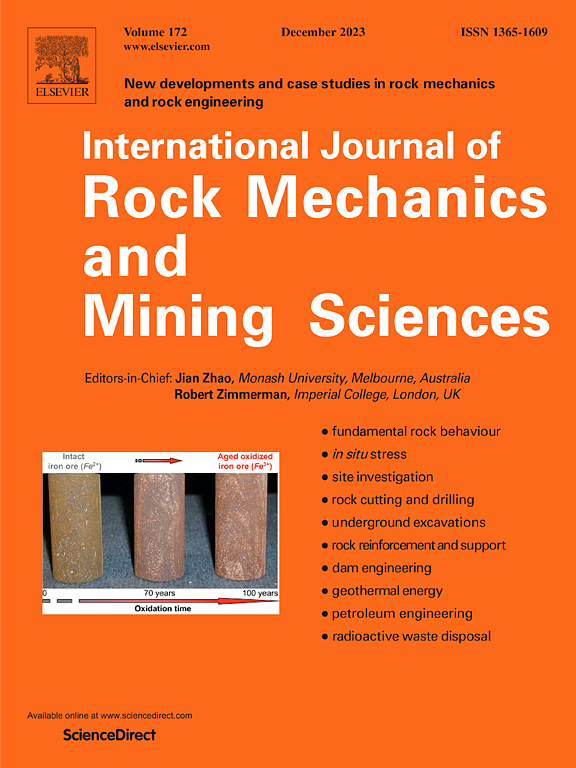Stress-dependent permeability in sedimentary rocks: A fractal model based on poroelastic compressibilities
IF 7
1区 工程技术
Q1 ENGINEERING, GEOLOGICAL
International Journal of Rock Mechanics and Mining Sciences
Pub Date : 2025-02-18
DOI:10.1016/j.ijrmms.2025.106055
引用次数: 0
Abstract
Stress variations in the subsurface can modify the permeability and the poroelastic compressibilities of rocks and soils. In general, stress-dependent permeability predictions are based on empirical models, which disregard the underlying connection between permeability and poroelastic compressibilites. In this work, we present a physically-based constitutive model to predict stress-induced permeability variations in sedimentary rocks accounting for the fact that drained pore compressibilities vary with the differential stress. The proposed model is based on a fractal conceptualization of the pore space and results in a closed analytical expression. We validate the proposed model with experimental measurements of pore compressibility and permeability in a series of sedimentary rocks by means of a fractal dimension parameter fitting. Results show that the corresponding fractal dimensions are in reasonable agreement with pore size distributions, obtained from thin section analysis, and capillary pressure saturation curves of the corresponding rocks, given by mercury intrusion tests. Finally, we compare the proposed model with alternative stress-dependent permeability models that are broadly used in the specific literature, such as, exponential and power law models, and attempt to provide these empirical models with a first order physical interpretation. The proposed approach and associated results may help estimating permeability from poroelastic compressibility measurements, which is, to date, widely regarded as a frontier in the overall fields of Geomechanics and Applied Geophysics.
沉积岩应力相关渗透率:基于孔隙弹性压缩率的分形模型
地下应力变化可以改变岩石和土壤的渗透性和孔隙弹性压缩率。一般来说,应力相关渗透率预测是基于经验模型的,忽略了渗透率和孔隙弹性压缩率之间的潜在联系。在这项工作中,我们提出了一个基于物理的本构模型来预测沉积岩中应力诱导的渗透率变化,该模型考虑了排水孔隙压缩性随差应力变化的事实。该模型基于孔隙空间的分形概念,并得到一个封闭的解析表达式。采用分形参数拟合的方法,对一系列沉积岩的孔隙压缩性和渗透率进行了实验测量,验证了该模型的有效性。结果表明,相应的分形维数与薄片分析得到的孔隙尺寸分布和压汞试验得到的相应岩石毛管压力饱和度曲线具有较好的一致性。最后,我们将所提出的模型与其他在特定文献中广泛使用的应力相关渗透率模型(如指数和幂律模型)进行比较,并试图为这些经验模型提供一阶物理解释。所提出的方法和相关结果可能有助于通过孔隙弹性压缩率测量来估计渗透率,迄今为止,孔隙弹性压缩率测量被广泛认为是地质力学和应用地球物理学整个领域的前沿。
本文章由计算机程序翻译,如有差异,请以英文原文为准。
求助全文
约1分钟内获得全文
求助全文
来源期刊
CiteScore
14.00
自引率
5.60%
发文量
196
审稿时长
18 weeks
期刊介绍:
The International Journal of Rock Mechanics and Mining Sciences focuses on original research, new developments, site measurements, and case studies within the fields of rock mechanics and rock engineering. Serving as an international platform, it showcases high-quality papers addressing rock mechanics and the application of its principles and techniques in mining and civil engineering projects situated on or within rock masses. These projects encompass a wide range, including slopes, open-pit mines, quarries, shafts, tunnels, caverns, underground mines, metro systems, dams, hydro-electric stations, geothermal energy, petroleum engineering, and radioactive waste disposal. The journal welcomes submissions on various topics, with particular interest in theoretical advancements, analytical and numerical methods, rock testing, site investigation, and case studies.

 求助内容:
求助内容: 应助结果提醒方式:
应助结果提醒方式:


